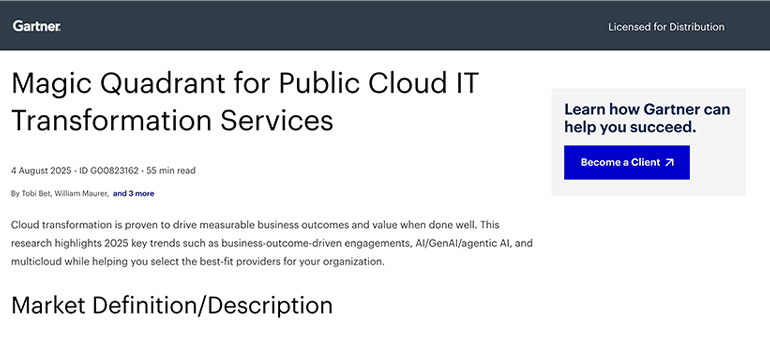Article Migrating to AWS - 5 Phase Migration Process

By Insight UK / 29 Jan 2019 / Topics: Cloud
The process of moving applications, data and the underlying infrastructure resources to a cloud computing environment is considered as "cloud migration". This can be driven by factors such as:
- Data centre upgrades
- Renewal of software licenses
- Global customer reach
- Improved system availability and reliability
- Improved security or cost savings
The reasons and the actual migration journey will be different for each organisation. However, irrespective of what the driver is, there are common phases that can be found in each successful cloud migration that form the basis of cloud migration best practice guidelines as recommended by AWS. These phases have been developed based on knowledge and experience gained from various organisations who moved their IT platforms to AWS cloud successfully. As such, every organisation considering a potential migration of their existing infrastructure to AWS is encouraged to adopt these best practises, which can be tailored to meet the individual needs of an organisation.

Figure 1: Five (5) Phase Migration Process (Source: https://aws.amazon.com/cloud-migration/)
Phase 1: Migration Preparation & Business Planning
This is the most significant phase as it involves setting out the direction, goals and potential timelines for migrating to AWS. The organisation will require a senior executive sponsorship to develop and endorse a cloud strategy around AWS. This has been found to be the primary enabler for driving and achieving the business goals. Furthermore, an executive steering group - consisting of a team of wider business stakeholders – will also be required to ensure the right combination of people, processes and technology are put in place.
At this early stage, the executive steering group will have various questions and unknowns around the required AWS cloud migration. In order to address these and enable the organisations move at pace, formation of a "Cloud Centre of Excellence" (CCoE) is highly recommended.
The CCoE will typically consist of the below roles and will be responsible for defining the Availability, Compliance, Reliability and Security objectives for the migration to AWS cloud:
- Lead architect
- AWS infrastructure engineers
- Security engineers
- Application engineers
- Operations engineers
Phase 2: Portfolio Discovery & Planning
To successfully plan the migration of workloads from private data centres to AWS, it is paramount to understand the complexity, interdependencies of the applications and the level of business dependency on these workloads. In addition, it is also important to collect data on resource utilisation, configurations and their behavioural patterns. This can then be used to derive the Total Cost of Ownership (TCO) of running the workload on AWS and form the future migration strategy, including the execution plans.
The migration plan should typically start from migrating the less critical and standalone applications via lift and shift. This will help build confidence within the team and the wider business stakeholders and also establish guidelines for future migrations.
There are various tools that can be used to assist during this stage. However, AWS Application Discovery Service is a native AWS tool available for use at no cost.
AWS Application Discovery Service
This is a tool that can be used to gather the application specific information from private data centres using agents or agentless discovery. Information can then exported for analysis in Microsoft Excel or AWS analysis tools such as Amazon Athena and Amazon QuickSight. It also integrates seamlessly with AWS Migration Hub which is used to track the status of the actual migration of workloads.
Phase 3 & 4: Designing, Migrating & Validating Applications
This is the execution phase of the migration plan where the focus is on the actual migration of applications to AWS. Based on the migration strategy adopted, it might be required to re-design applications to ensure they are optimised to run on the AWS cloud environment. This will then be followed with the migration and validation of the application operations. Developing a test plan for each application, which will be executed post migration as part of the validation process, is also a key requirement.
Integrate a continuous improvement methodology and iteratively review the design, migration and validation phases to get the applications fully operating on AWS. For each application that has been successfully migrated, conducting a Post Implementation Review (PIR) is highly recommended to ensure the learning is carried on to future application migrations.
Like the previous phase, AWS also provides a number of solutions and tools to assist clients during these phases too.
Server Migration
- VMWare Cloud on AWS: A joint offering by VMWare and AWS that allows customers to create vSphere data centres on AWS, making it easy to migrate on-premise vSphere workloads to AWS. Other use cases can be found here.
- AWS Server Migration Service: An agentless service that supports migrations of on-premise virtual machines (VMs) using a virtual appliance. It supports incremental replication of live server volumes to AWS which helps to reduce server downtime during cutover.
Database Migration
- Database Migration Service: Provides a quick and secure migration of on-premise databases to AWS, while the source database remains fully operational during the migration. IT supports both homogeneous migrations (e.g. MySQL on premise to MySQL on AWS) and heterogeneous migrations (e.g. PostgreSQL on premise to Microsoft SQL Server on AWS).
Data Transfer
- S3 Transfer Acceleration, AWS DataSync, AWS Transfer for SFTP, AWS Storage and File Gateway and AWS Snowball & Snowmobile: These tools can facilitate the transfer of on-premise datastore to storage services on AWS.
Phase 5: Modern Operating Model
Adopting a hybrid IT estate (partly on-premise and partly in the cloud) or migrating all workloads to AWS will require a revamp of the organisation’s operating model to make the most of the cloud environment. Applying exactly the same IT operations and processes used for running an on-premise environment to a more agile cloud environment will limit the potential of realising the full benefits of the migration. The combination of people, processes and technologies for managing the IT estate post migration will need to evolve, continually improving as the migration accelerates. AWS offers tools and methodologies which can be utilised to adapt to the cloud operating model, some of these include:
- DevOps: DevOps focuses on the collaboration between application developers, IT operations and security teams in order to automate and speed up the development and deployment of applications. It focuses on principles such as: Infrastructure as code, Continuous deployment, Automation, Monitoring and Security. AWS provides a wide range of tools and also support the use of third party products to help organisations align with these principles. For example, AWS native services (CodeCommit, CodeBuild and CodeDeploy) can be used to build a fully automated Continuous Integration and Continuous Deployment (CI/CD) pipeline for software build, test and deployment.
- Serverless: Also known as Functions as a Service (FaaS), is a minimalist cloud-computing model where application functions can be individually scheduled to be executed on demand, typically based on events. The cloud provider, in this case AWS, provides and dynamically manages the underlying compute resources that host and executes the application. Clients are only billed based on the compute time consumed rather than traditional application hosting where the client is billed for the resources even when the application is not being used. AWS Lambda provides the most versatile serverless platform available to develop and deploy serverless applications on any cloud platform today.
- AWS Well Architected Framework: AWS developed the well-architected framework based on best practices and core strategies for architecting systems in the cloud. The framework is based on the five pillars - operational excellence, security, reliability, performance efficiency and cost optimisation - which are the basis for building a highly secure, high-performing, resilient, and efficient infrastructure in the cloud. Using this framework, organisations can evaluate their cloud architecture and come up with a set of remediation activities that can be implemented to harness the power of AWS most efficiently.
Conclusion
Migrating to AWS can be a daunting task for an organisation that has primarily operated in an on-premise environment. However, taking the phased approach recommended in this article with due diligence on preparation, discovery and planning before embarking on the actual migration will ensure certainty in realising the business objectives.
If you are interested in finding out more, please contact your Insight Account Manager or get in touch via our contact form here.
Why not read part 2 of our Migrating to AWS series - "6 R’s Migration Strategy"



